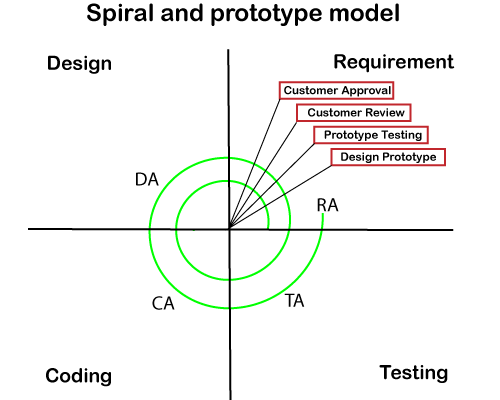The hybrid model is the combination of two or more primary (traditional) models and modifies them as per the business requirements. This model is dependent on the other SDLC models, such as spiral, V and V, and prototype models. The hybrid model is mainly used for small, medium, and large projects. It focuses on the risk management of the product.
We go for the hybrid model whenever we want to obtain the features of two models in a single model. And when the model is dependent and the customer is new to the industry.
The most commonly used combination of two models is as follows:
- Spiral and prototype
- V & V and Prototype
Spiral & Prototype
The spiral and prototype model is used for the below conditions:
- We go for spiral and prototype models whenever there is dependency.
- When the customer gives requirements in stages, and we develop the product in stages using this model.
- When the customer is very new to the software industry and not clear about the requirements.
- When the developers are new to particular software.
Process of Spiral and Prototype model
The process of spiral and Prototype model will complete in various steps, which are as follows:

- The process of this model starts with collecting the requirements from the customer for the different modules like A, B, and C
- After collecting the business needs of the software, we will create the prototype A.
- Once we develop the Prototype, we will test the Prototype A.
- After successfully testing the Prototype, we will send it to the customer for their review and approval.
- Once they reviewed and approved the Prototype, we will design that Prototype for the actual module.
- Once the designing phase completes, the developer starts writing the code for the modules.
- After the completion of development, it will send it to the testing team, where they will test the module.
- And when the testing phase is done, it will deploy to the customer.
And this process is continued until all the modules (B, C) present in the software.
V & V and prototype Model
We go for this model for the following reasons:
- When the customer and developers are both new to the industry.
- When the clients are expecting a very high-quality product within the required time because every phase is tested, and the developer and testing team are working parallelly.
V & V and Prototype model process
In the hybrid model, the testing team is involved to test the Prototype.
In this, testing will start from the early stage of product development, which avoids the downward flow of bugs, which helps us to reduce the re-work.

The V & V model and prototype process will be completed in the following steps:
Step1
The process starts with collecting the business needs in the form of CRS documents, and the tester will do the following:
- Review the CRS
- And write the user acceptance test case and test plans.
Step2
Then BA will convert this CRS document to the SRS document, and the web developer will design and develop the Prototype, send it to the tester, and the tester will test the following:
- First, they will review the SRS document.
- And Write the system testing test cases and test plans.
Step3
After that, the testing team will check the Prototype and identify the bugs and send it back to the concerned developer. Once the prototype testing is done, it is sent to the customer for their review and approval.
Step4
Once the customer approves it, we will design the high-level design of the particular Prototype and send it to the testing team where they will do the following:
- Review the HLD
- Writes the integration testing test documents.
Step5
Once it is done, we will start working on the low-level design and send it to the tester where they will perform the following:
- Review the LLD
- And writes the functional test cases and test plans.
Step6
After that, the developer starts writing the code for the particular Prototype and does one round of white box testing from their end and send it to the testing team for further testing where they perform various type of Testing.
This process is going on until the modules and prototypes are stable. And then it will deliver to the customer.
Advantage and disadvantages of Hybrid Model
Following are the pros and cons of the hybrid model:
Advantages
- The hybrid model is highly flexible.
- In this model, the customer rejection is less because of the Prototype.
- It is easy to implement because it has the flexibility of synchronization.
- It is easy to use and apply, especially with small and medium projects.
- In this, the development process will be smooth and quick because here we follow only the relevant process cycles.
Disadvantages
- Every hybrid model is different from each other.
- It does not follow the usual standards.



0 Comments